Spatial aspects of territorial development. Рубрика в журнале - Economic and Social Changes: Facts, Trends, Forecast
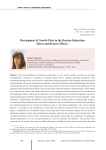
Development of growth poles in the Russian Federation: direct and reverse effects
Статья научная
The understanding of economic polarization as one of the possible sources of economic development is rooted in a number of scientific papers and in strategic planning documents. This understanding requires the revision of the implications that emerge due to the formation and development of growth poles. The goal of our present research is to develop an approach that will help assess the impact of growth poles on the surrounding space. Scientific novelty of the work consists in the justification of an approach to the identification of direct and reverse effects of the development of growth poles, which allows us to measure the scale of the impact they have on the territories concentrated around. Theoretical and methodological basis of the study is formed by a set of scientific ideas in the field of regional economics, spatial analysis and modeling. Using the assessment of spatial autocorrelation (by determining the values of Moran's Global Index and Moran's Local Index) and the implementation of cartographic analysis, we assess the relationships between individual constituent entities of the Russian Federation according to the resulting parameters of territory development such as “permanent population” and “gross regional product”. According to the calculations we prove that the influence of growth poles on the surrounding space is ambiguous: the territories located near large-scale socio-economic systems do not receive a significant impetus to their own development; moreover, they lose the resources they already have. The revealed pronounced reverse effect of economic polarization determines the importance of applying a balanced approach to the use of growth poles as a tool of economic development. The results of our research can be used in the work of public authorities at different levels and can also form the basis for further studies related to the measurement of the effects of development of growth poles and the development of priorities and mechanisms of regional policy, taking into account the interests of the territories that surround them.
Бесплатно
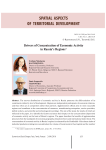
Drivers of concentration of economic activity in Russia's regions
Статья научная
The uneven distribution of economic activity in Russia promotes the differentiation of its constituent entities by level of development. Regions are independent participants of economic relations, and they often act as competitors rather than partners. Agglomeration effects arise in more successful regions and contribute to the concentration of resources, manufacturing enterprises, service providers, skilled workers, and scientific and technological knowledge. The aim of the study, the results of which are reflected in the paper, is to identify the factors and assess their impact on the concentration (dispersion) of economic activity on the basis of Russia's regions. The paper describes the benefits of agglomeration processes from the standpoint of economic geography, allocation theory and international trade theory. The concentration of economic activity in Russia's regions is estimated by the Herfindahl-Hirschman index of industrial production taking into consideration the volume of investments in fixed capital and the number of people employed in the economy in Russia's regions in 1990-2013...
Бесплатно
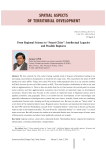
From regional science to “smart cities”: intellectual legacies and possible ruptures
Статья научная
We have entered the 21st century facing a global trend of massive urbanization leading to an increasing concentration of population in relatively few, large cities. This exacerbates the share of GDP produced in cities (80%). Today, more than 54% of the world population lives in a city and this number will likely increase by the end of this century to 80%. This trend implies a redefinition of what a city, and what an agglomeration, is. There is then no doubt that the city has become the central point in various social sciences and that agglomeration economics have become an important topic in development economics. Smart Cities have become in this context an important topic in Regional science and in applied economics and geography. There is no doubt that the development of new technologies and especially information technologies have created their own issues. Actually, Smart cities are combining a production function and a housing and living environment one. But one can also see “Smart cities” as a new form of the industrial district issue...
Бесплатно
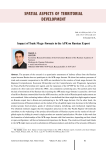
Impact of trade mega-formats in the APR on Russian export
Статья научная
He purpose of the research is a quantitative assessment of indirect effects from the Russian export because Russia does not participate in the APR mega-formats. We show that modern processes of trade and economic cooperation in the APR are manifested in the creation of trade mega-formats: the Regional Comprehensive Economic Partnership and the Comprehensive and Progressive Agreement for Trans-Pacific Partnership were signed, and the expansion of the CPTPP for the USA, as well as the creation of a free trade zone within the APEC, was considered a promising area. The authors prove that the lack of motivation of the Russian side in joining the APR trade mega-formats is caused by a low level of tariffs on Russian commodities from the APR countries, and the risks of Russian goods replacement are not considered. After evaluating indirect effects, it was defined that there might be a slight negative impact on Russian export due to Russia not participating in the APR mega-formats. On the other hand, the competitiveness of Russian products on the market of the sub-global region may decrease in the following product groups: food products, goods of chemical industry, metallurgy, and mechanical engineering. The obtained estimates suggest that the integration processes in the Asia-Pacific Region will indirectly contribute to the weakening of the product diversification of Russian exports on the market of the sub-global region by shifting it toward a single-product raw material specialization. We show in this work that the formation of relationships of the APR mega-formats with third countries, depending on their closed or open configuration, will have a fundamental importance for Russia. The creation of closed trade blocks in the APR might mean an active substitution of Russian products and decline of the amounts of Russia’s exports on the APR market. However, if open trade blocks are created, then the discrimination toward Russian goods would not be that clear.
Бесплатно
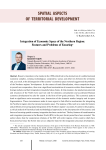
Integration of economic space of the northern region: features and problems of ensuring
Статья научная
Russia's transition to the market in the 1990s which led to the destruction of a unified national economic complex, existing technological, cooperative, social, and other ties between the territories and, as a result, to the disintegration of the country's economic space extremely aggravated the problems of the Northern regions' development. In the context of trade liberalization, when competition began to prevail over cooperation, there was a significant reorientation of economic entities from domestic to foreign markets and their integration into global value chains. In this situation, the production potential and resources of the North were used not only for domestic consumption and accelerated Russian economy development but also for export in the form of low-grade products. This economic pattern leads to significant socio-economic costs, destruction of the domestic market integrity and its space fragmentation. These circumstances make it more urgent to find effective mechanisms for integrating the Northern regions into the national economic space. The purpose of this work is to study the features and problems of ensuring spatial integration of the Northern region's economy. To achieve this purpose, a critical analysis of theoretical and methodological approaches to the interpretation of the essence and factors of ensuring spatial economy integration has been carried out. The key features of transformation and integration processes in the Russian North (RN) in the post-Soviet period have been revealed. The author shows that the cooperation relations of the RN with other regions of the country which have been preserved since the Soviet time are an objective basis for the integration processes development. However, their progress is hindered by negative demographic processes that limit the integration development in the region's labor market; a decrease in the space transport connectivity level due to the significant destruction of the system of intraregional aviation and inland water transport. The paper identifies transport connectivity of the main economic centers of the RN and “bottlenecks” in the region's transport infrastructure development. The authors substantiate conceptual basis for ensuring spatial integration of the Northern region's economy.
Бесплатно
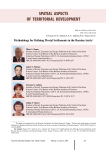
Methodology for defining pivotal settlements in the Russian Arctic
Статья научная
Settlement in new regions of the Russian North, available for new economic exploitation, started at the beginning of the 20th century: the exploration of mineral deposits, its mining and shipment into southern regions commenced at the same time. Experience of building cities as trade and industrial centers, marine ports, and military settlements, which was acquired in the 18th-19th centuries, was insufficient. It was necessary to define forms of settlement, quantitative parameters of emerging communities, and convenience of the latter. Discussions and knowledge acquisition resulted in a consent to build permanently populated large cities. It was suggested to build basic cities in the North and pivotal cities, which would have infrastructural functions, in nearby areas. Quantitative guidelines on population numbers for each type of settlement were proposed: pivotal cities - 300 thousand residents, basic cities - 80-150 thousand people, industrial cities - 15-30 thousand inhabitants, watch and expeditionary villages- 3-5 thousand people. After making the Arctic Zone in the Russian North the independent management unit consisting of nine pivotal areas, it became necessary to justify settlement framework, which would meet new requirements. Thus, the purpose of this article is to develop the methodology of calculating the Index of Pivotal Settlement which would allow us to classify an urban settlement as a multifunctional pivotal settlement, a pivotal settlement, a potential pivotal settlement, and as a settlement which does not meet criteria of a pivotal one. The creation of this index is based on three methodological principles: complexity, consistency, and account of agglomeration effect. The calculation of the index of the Arctic pivotal settlements is carried out due to the concept of demographic gravitation. Acquired results would allow each Arctic pivotal area to determine pivotal settlements, and the centers of surrounding areas development.
Бесплатно
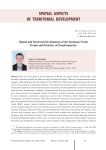
Spatial and territorial development of the European North: trends and priorities of transformation
Статья научная
One of the key goals in the development of Russia, the largest country in the world, is the necessity to provide optimal and efficient usage of its huge territories. However, transformational market changes, which happened after the collapse of the USSR in the 1990s, led to a sharp decrease in the state's role in the governance of spatial development. This policy had extremely negative economic and social implications: settlement contrast increased due to the production and population's retraction into areas of concentration. Simultaneous “washing” of population out from deep regions also took place. At the same time, these problems are especially relevant for Russia's northern territories, which are characterized by focal settlement, production's placement, and for other territories, which experienced negative consequences of market transition. These factors justify the relevance of this research. The goal of the paper is to study the features and substantiate priority areas of perfecting governance of Russian European North (REN) regions' spatial territorial development. Theoretical and methodological approaches toward understanding the essence of economic space and its development, the analysis of key trends and specifics of Russian European North's spatial development in the post-soviet period were studied. Also, we prove that economic space of REN is currently linear-nodular with significant areas of economic periphery. The article shows the role of first- and second-class nods in preserving supporting carcass of territories of Russian European North. Also, it is shown that such settlement systems might be a basis for formation and development of polycentric model of region's space organization. This model is aimed at the revival and development of sustainable socio-economic and technological connections through the system “large city-small town-village”.
Бесплатно
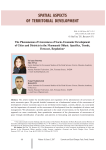
Статья научная
The article studies the transformation and regulation of the phenomenon of unevenness of socio-economic space. We provide detailed comments on a fundamental nature of the unevenness of development of socio-economic space in any territorial entity (region, country, district, etc.) and point out the importance of research on the unevenness of development from the standpoint of science and management. We substantiate a priority approach to the study of unevenness; in the framework of this approach we move consistently from quantitative assessment of the phenomenon of unevenness of space through identification of specifics and patterns to forecasting and practical recommendations for management. All this is related to the prospects of further research. We present the importance and relevance of this study, which aims to identify specifics of the phenomenon of unevenness of socio-economic development of cities and districts of the Murmansk Oblast, and to forecast its dynamics and regulation in present-day crisis conditions...
Бесплатно

